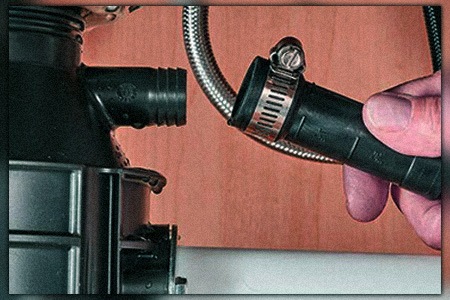An Guide to Resolving a Leak in Your Garbage Disposal
An Guide to Resolving a Leak in Your Garbage Disposal
Blog Article
They are making a number of great annotation on Why Is in general in the content underneath.

Waste disposal unit are essential kitchen home appliances that help in disposing of food waste effectively. Nevertheless, a dripping waste disposal unit can be a frustrating and untidy issue to manage. Thankfully, lots of leakages can be taken care of conveniently with a couple of simple steps. In this write-up, we will review how to take care of a dripping waste disposal unit successfully.
Intro
Garbage disposals are installed under cooking area sinks and are created to shred food waste into smaller sized items, allowing it to travel through the plumbing system quickly. While these tools are typically trusted, leakages can take place in time as a result of deterioration, loose links, or damages to the unit.
Typical Reasons For Leakages in Garbage Disposals
Worn Seals and Gaskets
Seals and gaskets play an important duty in preventing water from dripping out of the waste disposal unit. Over time, these components can deteriorate, resulting in leaks around the disposal unit.
Loose Connections
The connections in between the waste disposal unit and the plumbing system can come to be loose over time, creating water to leakage out during operation.
Splits or Holes in the Disposal Device
Physical damages to the garbage disposal, such as splits or openings in the real estate, can additionally cause leakages.
Identifying the Resource of the Leakage
Prior to trying to take care of a dripping waste disposal unit, it is vital to recognize the resource of the leak. This can usually be done with visual inspection or by conducting straightforward examinations.
Visual Assessment
Examine the garbage disposal device very carefully for any signs of water leak. Pay close attention to locations around seals, gaskets, and connection factors.
Examining for Leaks
One means to evaluate for leakages is by running water through the disposal system and looking for any type of noticeable signs of leakage.
Tools and Products Needed for Fixing a Leaking Waste Disposal Unit
Before beginning the repair service process, collect the essential tools and materials, consisting of a screwdriver, adjustable wrench, plumbing's putty, replacement seals or gaskets, and epoxy or patching product for fixing fractures or holes.
Step-by-Step Overview to Taking Care Of a Leaking Waste Disposal Unit
Shut off the Power
Prior to attempting any repairs, make sure that the power to the garbage disposal system is turned off to avoid the threat of electric shock.
Find the Leak
Determine the exact area of the leak and establish the cause.
Tighten up Connections
Use a wrench to tighten up any kind of loose links in between the disposal unit and the plumbing system.
Replace Seals or Gaskets
If the leak is because of used seals or gaskets, get rid of the old parts and change them with brand-new ones.
Patching Splits or Openings
For splits or openings in the disposal system, use epoxy or an appropriate patching material to seal the broken location.
Checking the Waste Disposal Unit After Repair
Once the repair is full, check the garbage disposal by running water through it to make sure that the leak has been solved.
Preventive Upkeep Tips to Prevent Future Leakages
To stop future leaks, it is necessary to perform regular maintenance on your garbage disposal. This consists of keeping it tidy, preventing placing non-food items or hard items down the disposal, and periodically checking for leakages or other problems.
Verdict
In conclusion, taking care of a dripping garbage disposal is a reasonably straightforward process that can be finished with standard tools and materials. By following the steps detailed in this article and practicing preventive maintenance, you can keep your garbage disposal in good working condition and avoid costly repairs in the future.
What to Do About a Leaking Garbage Disposal
A leaking garbage disposal often goes unnoticed until you confront a sopping cabinet, a foul-smelling puddle, or an audible drip-drip-drip from the unit. The fix can be frustrating, too, because the leak can stem from a number of components in the system. Fortunately, with a little sleuthing, you can zero in on the leak and—depending on the exact location—stop the icky oozing and repair the component that caused it. Worst case scenario, if it turns out that the garbage disposal must be replaced, installing a new one is a reasonable do-it-yourself task for those with basic plumbing skills. Read on to keep the cash you’d otherwise hand over to a pro.
Prepare to find the leak
Prior to testing the garbage disposal for leaks, unplug it at the wall outlet and turn off the power from the breaker box to prevent electrical shock. Then insert a watertight sink stopper into your sink drain and wipe the unit dry with a clean cloth. In any handy container, mix a few drops of food coloring into a few cups of water, and pour the dyed water onto the sink stopper to help you locate the leak.
Investigate the source
the top, where the disposal meets the sink drain the side, where the dishwasher hose or main drain pipe connects to the disposal or the bottom of the unit Inspect each of these locations while gliding a light-colored rag over the unit; the dyed water will readily show on the rag and reveal the location of the leak. If a leak isn’t immediately apparent, remove the sink stopper and pour a few more cups of dyed water down the sink drain, then check for leaks again. Leaks near the top of the unit are more likely to show themselves while the sink is plugged, while side and bottom leaks are more noticeable while the sink is unplugged.
The metal sink flange that sits directly inside the sink drain is typically sealed around the top with plumber’s putty (a clay-like sealant) and then secured from under the sink with bolts. If the plumber’s putty deteriorates, or the bolts loosen, the flange can no longer form a watertight seal between the sink drain and the disposal—which could cause a leak at the top of the unit.
To reseal the leaky flange, you must first detach the garbage disposal. Start by loosening the screws securing the main drain pipe to the disposal, then loosen the screws in the metal clamp securing the dishwasher hose to the disposal and detach the drain pipe and dishwasher hose from the disposal. Loosen the screws in the mounting ring that connects the disposal to the metal mounting assembly beneath the sink, then pull down the disposal and carefully set it on a clean, dry surface. Loosen the bolts in the mounting assembly with a wrench, then pull down the mounting assembly and set it near the disposal.

Hopefully you enjoyed our post on Why Is My Garbage Disposal Leaking From the Bottom?. Thanks for taking a few minutes to browse our content. Those who enjoyed reading our blog entry if you please remember to share it. We thank you for reading our article about Tips on Fixing a Leaking Garbage Disposal.
Click On This Link Report this page